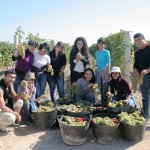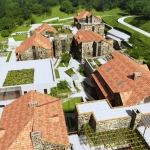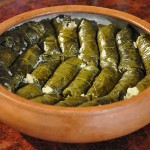New Year is one of the most favorite holidays in the Armenian calendar of festivals to which both adults and children are looking forward with great expectations. During the centuries because of changes in the calendar this holiday which symbolizes the beginning of the year in Armenia lifestyle has had various names, such us “Navasard,” “Amanor,” “Tareglukh,” “Avetis,” “Kaghand.”
In the Armenian traditional lifestyle the name New Year has prevailed and reached to us and the name “Kaghand” was mainly used in Western Armenia. The word “Kaghand” has penetrated into the Armenian language from the Latin expression “calendaa” which means “the first day of the month,” and the Greek word “kalanse” that is etymologized as the first day of each month. The word “Kaghand” has also the meaning of “to call” and “to name.” Its origin goes back to the pre-Christian times when on the first day of each month the priests summoned people to worship. From those times the first day of the month was called “Kaghand.” In the Christian era the word “Kaghand” became synonymous to New Year. The other words originated from “Kaghand” are “calantrie” (calendar) and “kaghandcheck.” The latter meant a present given on the day of Kaghand. That gift could be both material and verbal expressing wishes and congratulations followed by religious songs and ritual ceremonies. It was customary in Armenia to congratulate each other and exchange gifts in the evening before the day of Kaghand. According to tradition children singing and dancing in groups visited the houses of neighbors and hanged stockings or baskets from the opening in the roof and chimney for the hostesses to fill them gifts and sweets, such us gata, raisins and dried fruits. This ceremony was known as “kakhuk” or “gotekakh.”
In ancient Armenia there was a tradition of sprinkling water. According to that tradition at midnight young people went to the wellspring of the village and sprinkled the water by spraying into it seeds and fruits or they wet the ritual breads with
that water. They believed that exactly at midnight it was flowing gold from the wellspring instead of water but only for a moment, and tried to bring water the very moment.
The traditions of “Kaghand tree” and “Kaghand Pap” have deep roots in the Armenian mode of life. At the end of the 19th century the Armenians used olive-tree as Christmas-tree, the branches of which were blessed in churches. After blessing the branches of the olive-tree people took them to their houses and put them into the ritual breads which they placed in the middle of the table. The branches were decorated with nuts, walnuts and dried fruits. People believed that the adorned kaghand-tree would bring success and fortune to the family. There is preserved a tradition about Kaghand Pap (Christmas Grandfather or Armenian Santa Claus) referred to Catholicos Sahak Partev. According to this tradition people called him “Mets Papuk” (Great Santa) and found in his image some features characteristic to Kaghand Pap. On the day of Kaghand when all the members of the family assembled around the table one of the eldest members quietly left the room and then suddenly entered with skullcap on head, big cane in hand and sheepskin on his back. He was considered to be Kaghand Pap that spread out merry festive mood in the house with which the celebration of New Year started. People in some regions of Armenia had a custom in the evening of Kaghand to take the pieces of a log burnt at the previous night to the field and to bury them. They believed that the log which was called “Taremuti Qotuk” (New Year’s stub) being buried in the field will make the harvest plentiful that year. According to the tradition people used to light a candle in their houses at the night of Kaghand to keep kindness and warmth inside the house.
Kaghand – Armenian Santa Clouse
Back To Top










